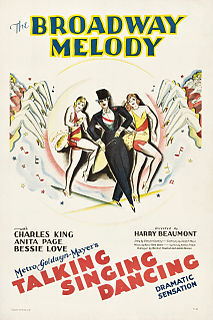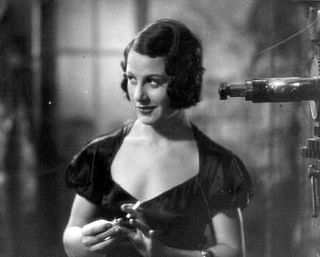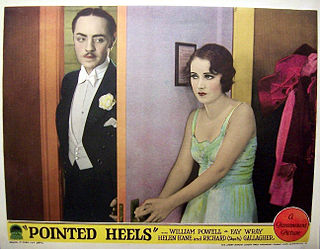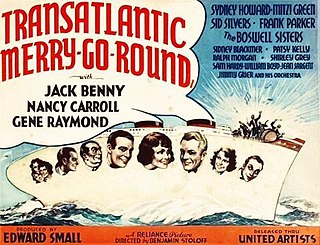
Musical film is a film genre in which songs by the characters are interwoven into the narrative, sometimes accompanied by dancing. The songs usually advance the plot or develop the film's characters, but in some cases, they serve merely as breaks in the storyline, often as elaborate "production numbers".

The Hollywood Revue of 1929, or simply The Hollywood Revue, is a 1929 American pre-Code musical comedy film released by Metro-Goldwyn-Mayer. It was the studio's second feature-length musical, and one of their earliest sound films. Produced by Harry Rapf and Irving Thalberg and directed by Charles Reisner, it features nearly all of MGM's stars in a two-hour revue that includes three segments in Technicolor. The masters of ceremonies are Conrad Nagel and Jack Benny.

Maurice Auguste Chevalier was a French singer, actor and entertainer. He is perhaps best known for his signature songs, including "Livin' In The Sunlight", "Valentine", "Louise", "Mimi", and "Thank Heaven for Little Girls" and for his films, including The Love Parade, The Big Pond, The Smiling Lieutenant, One Hour with You and Love Me Tonight. His trademark attire was a boater hat and tuxedo.

The Broadway Melody, also known as The Broadway Melody of 1929, is a 1929 American pre-Code musical film and the first sound film to win an Academy Award for Best Picture. It was one of the first musicals to feature a Technicolor sequence, which sparked the trend of color being used in a flurry of musicals that would hit the screens in 1929–1930. Today, the Technicolor sequence survives only in black and white. The film was the first musical released by Metro-Goldwyn-Mayer and was Hollywood's first all-talking musical.
This is a list of notable events in music that took place in the year 1930.
The following is an overview of 1930 in film, including significant events, a list of films released and notable births and deaths.
The House That Shadows Built (1931) is a feature compilation film from Paramount Pictures, made to celebrate the 20th anniversary of the studio's founding in 1912. The film was a promotional film for exhibitors and never had a regular theatrical release.

King of Jazz is a 1930 American pre-Code color musical film starring Paul Whiteman and his orchestra. The film title refers to Whiteman's popular cultural appellation. At the time the film was made, "jazz", to the general public, meant jazz-influenced syncopated dance music heard on phonograph records, on radio broadcasts, and in dance halls. In the 1920s Whiteman signed and featured white jazz musicians including Joe Venuti and Eddie Lang, Bix Beiderbecke, Frank Trumbauer, and others.

Elstree Calling is a 1930 British comedy musical film directed by Adrian Brunel and Alfred Hitchcock at Elstree Studios.

Mitzi Green was an American child actress for Paramount and RKO, in the early "talkies" era. She then acted on Broadway and in other stage works, as well as in films and on television.

One Romantic Night is a 1930 American pre-Code romantic comedy film directed by Paul L. Stein. It is the first sound film version of Ferenc Molnár's play The Swan, and marked silent screen star Lillian Gish's talkie debut. She starred as Princess Alexandra, with Conrad Nagel as the tutor who falls in love with her, and Rod La Rocque as Crown Prince Albert. The film was only fairly successful, though Gish would go on to become as highly regarded in talking pictures as she had been in silent films.

The Show of Shows is a 1929 American pre-Code musical revue film directed by John G. Adolfi and distributed by Warner Bros. The all-talking Vitaphone production cost $850,000 and was shot almost entirely in Technicolor.

Paris is a 1929 American Pre-Code musical comedy film, featuring Irène Bordoni. It was filmed with Technicolor sequences: four of the film's ten reels were originally photographed in Technicolor.

Paula Iliescu Gibson known professionally as Pola Illery, was a Romanian-American actress and singer, best known for her appearances in early French film, and of the latter after emigrating to the United States, in Hollywood films, best known for her portrayal of vamps, she appeared in both silent film and talkie films, in a decade long screen career between 1928 and 1938.

Charles d'Authier de Rochefort was a French film actor, principally of the silent era. He appeared in 34 films between 1911 and 1932. He also directed seven films between 1930 and 1931.

Nino Martini was an Italian operatic tenor and actor. He began his career as an opera singer in Italy before moving to the United States to pursue an acting career in films. He appeared in several Hollywood movies during the 1930s and 1940s while simultaneously working as a leading tenor at the Metropolitan Opera in New York City.

Pointed Heels is a 1929 American pre-Code early sound musical comedy film from Paramount Pictures that was directed by A. Edward Sutherland and starring William Powell, Helen Kane, Richard "Skeets" Gallagher, and Fay Wray. This film was originally filmed in color sequences by Technicolor, but today those color sequences only survive in black-and-white. One of these color sequences was the "Pointed Heels" ballet with Albertina Rasch and her Dancers.

Transatlantic Merry-Go-Round is a 1934 American drama film with musical and comedic elements, directed by Benjamin Stoloff.
Honey is a 1930 American comedy film directed by Wesley Ruggles and written by Herman J. Mankiewicz. It is based on the 1916 novel Come Out of the Kitchen! by Alice Duer Miller. The film stars Nancy Carroll, Harry Green, Lillian Roth, Richard "Skeets" Gallagher, Stanley Smith and Mitzi Green. The film was released on March 29, 1930, by Paramount Pictures.

The Social Lion is a 1930 American Pre-Code comedy film directed by A. Edward Sutherland and written by Octavus Roy Cohen, Joseph L. Mankiewicz and Agnes Brand Leahy, and starring Jack Oakie, Mary Brian, Richard "Skeets" Gallagher, Olive Borden, Charles Sellon, Cyril Ring and E. H. Calvert. It was released on June 21, 1930, by Paramount Pictures.

















